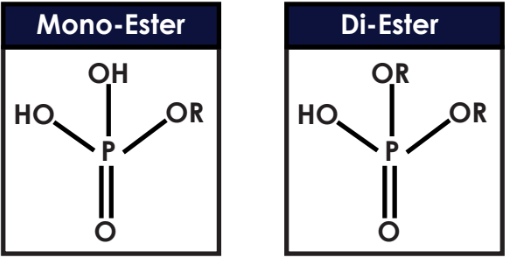Knowde Enhanced TDS
Identification & Functionality
- Agrochemical Functions
- Cleaning Ingredients Functions
- Industrial Additives Functions
- Product Families
- Chemical Structure of Phosphate Esters

Features & Benefits
- Labeling Claims
- Industrial Additives Features
- General Properties of Phosphate Esters
- Alkali Stability and Solubility
- Coupling and Emulsification
- Detergency and Rinse-ability
- Increased Hard Water Tolerance
- Corrosion Inhibition
- Lubricity
- Wetting
- Thermal Stability
- Background on Phosphate Esters
- Phosphate Esters are anionic surface active agents produced by reacting polyphosphoric acid or phosphorous pentoxide with molecules containing hydroxyl groups - commonly ethoxylated moieties or alcohols. Reactions using phosphorous pentoxide result in a mix of mono and di-esters, while products made with polyphosphoric acid are high in mono-ester yield.
- Which type to use depends upon the properties needed in formulation. Mixed esters products are generally better for emulsification; whereas, mono- ester rich exhibit better hydrotroping properties.
Applications & Uses
- Markets
- Applications
- Applicable Processes
- I&I Cleaning Applications
- Industrial Additives End Use
Properties
- Physical Form
- Appearance
- Yellow liquid
- Soluble in
- Water, Ethanol, Xylene
- Insoluble in
- Mineral oil, Kerosene, Perchloroethylene
- Typical Properties
- Compatibility
T-Mulz 1227 is compatible with anionic and nonionic surfactants. This product should not be mixed with concentrated oxidizing agents or reducing agents, as the mixture of these compounds with organic compounds form a potentially explosive mixture.
| Value | Units | Test Method / Conditions | |
| Activity | min. 99 | % | - |
| Caustic Solubility (in 18% NaOH at 25°C) | 17.4 | - | - |
| Color | max. 4 | Gardner | Color (Gardner) |
| Flash Point | min. 250 | °F | PMCC |
| Moisture Content | max. 1.0 | % | - |
| pH (at 1% aqueous Solution) | 1.5 - 2.5 | - | - |
| Pour Point | 40.0 | °F | - |
| Acid Value (at pH 5.5 - 9.5) | 139 - 257 | mg KOH/g | - |
| Specific Gravity (at 68°F) | 1.1 | - | - |
| Weight (at 68°F) | 9.2 | lbs/gal | - |
| Surface Tension (0.05% aqueous at 77°F) | 27.0 | dynes/cm | - |
| Cloud Point (at 1% in 17% NaOH aq.) | min. 60 | °F | - |
Regulatory & Compliance
- Certifications & Compliance
Storage & Handling
- Storage & Handling Information
- T-Mulz 1227 is regarded as corrosive and should be handled as such.
- It should not be used in products for internal use.

